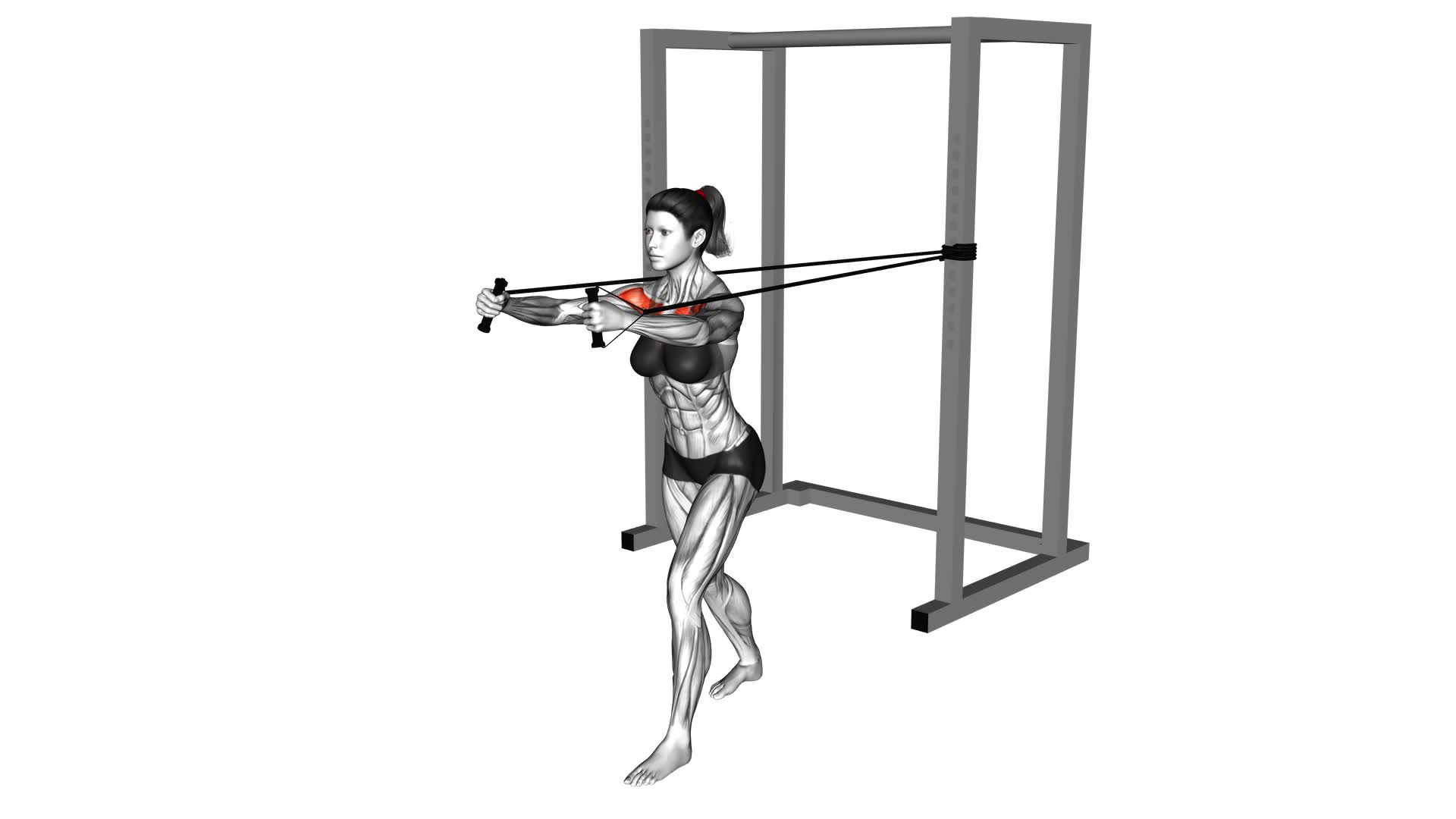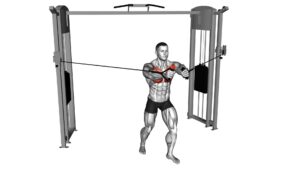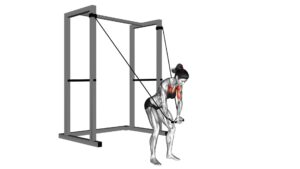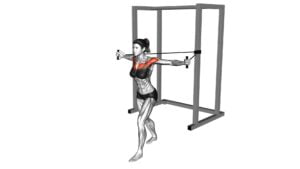Band Middle Fly (female) – Video Exercise Guide & Tips

Get ready to strengthen and tone your muscles with the Band Middle Fly exercise. In this video exercise guide, you'll learn the proper form and technique, as well as helpful tips to maximize your results.
Watch This Exercise Video
Whether you're a beginner or experienced, this exercise is suitable for all fitness levels. Grab your resistance band and get ready to fly towards a stronger, healthier you.
Let's dive in and start the workout!
Key Takeaways
- Band Middle Fly targets chest and shoulder muscles, strengthening and toning the upper body.
- Proper form and technique are crucial to avoid straining the neck, upper back, and shoulder joints.
- Resistance bands are versatile and affordable equipment that can be used for this exercise.
- Modifications and variations, such as single-arm fly and different resistance levels, can be incorporated for increased challenge and muscle growth.
Benefits of Band Middle Fly Exercise
The Band Middle Fly exercise offers numerous benefits for you. When performing this exercise, you primarily target the muscles in your chest and shoulders. Specifically, the band middle fly works your pectoralis major, which is the large muscle in your chest, as well as your deltoids, which are the muscles in your shoulders. By engaging these muscles, you can effectively strengthen and tone your upper body.
To progress in the band middle fly exercise, you can increase the resistance of the band or use a heavier band. This will challenge your muscles and help you continue to build strength. Additionally, you can vary the angle of your arms during the exercise to target different areas of your chest and shoulders.
Proper form and technique for the band middle fly are crucial to maximize the benefits and prevent injuries. In the next section, we'll discuss the correct form and technique for this exercise, ensuring that you perform it safely and effectively.
Proper Form and Technique for Band Middle Fly
To perform the Band Middle Fly exercise with proper form and technique, start by standing with your feet shoulder-width apart and gripping the resistance band with both hands.
Here are some key tips to ensure you maximize the benefits of this exercise:
- Maintain proper band tension: As you pull the resistance band apart, focus on keeping a constant tension throughout the movement. This will engage your muscles more effectively and help you get the most out of the exercise.
- Activate your chest and back muscles: To target the middle part of your chest and strengthen your back muscles, focus on squeezing your shoulder blades together as you pull the band apart. This will activate those muscle groups and promote better overall muscle development.
- Control the movement: It's important to perform the Band Middle Fly exercise in a controlled manner. Avoid using momentum and instead, focus on a slow and controlled movement. This won't only enhance muscle activation but also reduce the risk of injury.
Equipment Needed for Band Middle Fly Exercise
You will need a resistance band for the Band Middle Fly exercise. The resistance band provides the necessary tension to engage and strengthen your muscles effectively. It's a versatile and affordable piece of equipment that can be easily incorporated into your workout routine.
If you don't have a resistance band, there are alternative resistance options you can use. One option is to use dumbbells or kettlebells instead. Hold the weights in each hand and perform the exercise in the same manner as with the resistance band. Another option is to use a cable machine if you have access to one. Attach the handles to the cable machine and adjust the weight accordingly to provide resistance.
When incorporating the resistance band into your workout, it's important to choose a band with the appropriate resistance level for your fitness level. Start with a lighter resistance band and gradually increase the resistance as you become stronger. Additionally, ensure that the band is securely anchored to a stable object or around your feet to avoid any accidents or injuries during the exercise.
Remember to maintain proper form and technique throughout the exercise to maximize its effectiveness and minimize the risk of injury.
Modifications and Variations of Band Middle Fly
Now that you have mastered the basic form of the Band Middle Fly, it's time to explore some modifications and variations to challenge yourself even further.
Remember to maintain proper form throughout the exercise to ensure maximum effectiveness.
If you're looking for alternative resistance options, consider using different strength bands or adjusting the tension of your current band.
For those looking to take their workout to the next level, advanced variations can be incorporated to provide a greater challenge and promote muscle growth and strength.
Proper Form Tips
For optimal performance and effectiveness, focus on proper form during band middle fly exercises by incorporating modifications and variations. Here are some tips to help you maintain the correct form and get the most out of your workout:
- Start with a lighter resistance band and gradually increase the tension as you become more comfortable with the exercise.
- Keep your core engaged and maintain a neutral spine throughout the movement to avoid straining your lower back.
- Focus on squeezing your shoulder blades together as you pull the band apart, rather than just extending your arms.
By following these form tips, you can ensure that you're targeting the right muscles and maximizing the benefits of the band middle fly exercise.
Now, let's explore alternative resistance options that you can incorporate into your workout routine.
Alternative Resistance Options
To add variety and challenge to your band middle fly exercises, try incorporating different resistance options that can help intensify your workout. Here are some alternative resistance options, modifications, and variations you can try:
- Increase band tension: Use a band with higher resistance to make the exercise more challenging. This will engage your muscles even more and help build strength.
- Single-arm fly: Instead of using both arms simultaneously, perform the exercise with one arm at a time. This will increase the demand on your stabilizer muscles and provide a different stimulus for your muscles.
- Standing middle fly: Instead of sitting on a bench or stability ball, try performing the exercise in a standing position. This will engage your core muscles and challenge your balance.
- Resistance band with handles: If you have access to resistance bands with handles, you can use them instead of loop bands. This will allow for a different grip and potentially different muscle activation.
Incorporating these alternative resistance options, modifications, and variations can help keep your band middle fly exercises fresh and ensure continued progress in your workouts.
Advanced Variations for Progression
To advance your band middle fly exercises and continue progressing, you can incorporate modifications and variations. Here are three advanced modifications that will take your workout to the next level:
- Single-Arm Band Middle Fly: Perform the exercise with only one arm at a time, focusing on engaging your core and maintaining balance.
- Band Middle Fly with Resistance Bands: Attach resistance bands to the handles of your band and increase the tension to challenge your muscles even more.
- Plyometric Band Middle Fly: Add an explosive element to your workout by performing the exercise with a jump. This will increase the intensity and target your muscles in a different way.
By incorporating these advanced modifications into your routine, you'll continue to challenge your muscles and see progress in your strength and stability.
Keep pushing yourself and striving for improvement.
Common Mistakes to Avoid During Band Middle Fly
To perform the Band Middle Fly exercise correctly, it's crucial to avoid two common mistakes: incorrect band positioning and lack of proper form.
Incorrect band positioning can lead to ineffective targeting of the desired muscles and can put unnecessary strain on other areas of the body.
Lack of proper form, such as rounding the back or hunching the shoulders, can diminish the effectiveness of the exercise and increase the risk of injury.
Incorrect Band Positioning
During the Band Middle Fly exercise, make sure you avoid placing the band in the incorrect position. Common errors to watch out for include:
- Placing the band too high on your chest, which can limit the range of motion and effectiveness of the exercise.
- Allowing the band to slide down towards your abdomen, which can cause strain on your lower back.
- Not securing the band tightly enough, resulting in it slipping or moving during the exercise.
To troubleshoot these issues, ensure that the band is positioned across your chest, just below the shoulders. Check that it's secure and snug, but not too tight. This will allow for proper resistance and engagement of the chest muscles.
By avoiding these common mistakes, you can optimize the benefits of the Band Middle Fly exercise.
Now let's move on to the next section about the importance of maintaining proper form.
Lack of Proper Form
Avoid these three common mistakes to ensure proper form during the Band Middle Fly exercise.
- The first mistake to avoid is rounding your shoulders forward. This not only puts strain on your neck and upper back, but also reduces the effectiveness of the exercise. Keep your shoulders pulled back and down throughout the movement.
- The second mistake is using momentum instead of controlled movements. Remember to focus on the muscles being targeted and perform the exercise in a slow and controlled manner.
- Lastly, avoid letting your elbows drop below your shoulders. This can put unnecessary stress on your shoulder joints.
Tips for Incorporating Band Middle Fly Into Your Workout Routine
Maximize the effectiveness of your workout routine by incorporating band middle fly exercises into your regimen. This exercise, which involves using resistance bands to target your chest muscles, can help you strengthen and tone your upper body.
Here are three tips for incorporating band middle fly into your workout routine:
- Start with the right resistance: Choose a resistance band that challenges you but still allows you to maintain proper form throughout the exercise. If the band feels too easy, try using a band with more resistance. On the other hand, if the band feels too difficult, switch to a band with less resistance.
- Focus on proper form: To get the most out of this exercise, it's essential to maintain proper form. Stand with your feet shoulder-width apart, hold the resistance band with both hands, and keep your arms parallel to the floor. Engage your chest muscles as you bring your hands together in front of your chest, and then slowly return to the starting position.
- Add variety to your routine: To prevent plateaus and keep your workouts interesting, consider incorporating different variations of the band middle fly exercise. You can try performing it on an incline bench or incorporating it into a circuit workout with other exercises targeting the chest and upper body.
Incorporating band middle fly exercises into your workout routine can help you strengthen your chest muscles and improve your overall upper body strength. Remember to start with the right resistance, focus on proper form, and add variety to your routine for optimal results.
Frequently Asked Questions
How Many Repetitions and Sets Should I Do for the Band Middle Fly Exercise?
To determine the number of repetitions and sets for the band middle fly exercise, consider your fitness level and goals. Start with 2-3 sets of 8-12 repetitions, focusing on proper form and control.
Gradually increase the intensity by adding more sets or reps as you progress. Remember to perform the exercise correctly by maintaining a slight bend in your elbows, engaging your core, and avoiding jerky movements.
Avoid common mistakes like using too much resistance or sacrificing form for quantity.
Can I Use Resistance Bands of Different Resistance Levels for the Band Middle Fly Exercise?
Yes, you can definitely use resistance bands of different resistance levels for the band middle fly exercise. This allows you to adjust the intensity and challenge yourself as you progress.
Using bands with higher resistance will provide more tension and increase the difficulty of the exercise.
However, if you don't have bands of different resistance levels, you can also try alternative exercises like dumbbell flys or cable flys to target the same muscle group.
Is the Band Middle Fly Exercise Suitable for Beginners?
Proper form is crucial for the band middle fly exercise. It's important for beginners to focus on maintaining the correct posture and technique to avoid injury.
This exercise targets the muscles in your chest, shoulders, and upper back, helping to improve upper body strength and posture. It also helps to tone and sculpt your chest and shoulders.
Incorporating this exercise into your workout routine can provide many benefits for beginners and experienced individuals alike.
Can I Do the Band Middle Fly Exercise Without Any Equipment?
Yes, you can do the band middle fly exercise without any equipment. If you don't have a resistance band, there are alternative exercises you can try that target the same muscles.
However, using a resistance band offers additional benefits, such as increasing the intensity of the workout and providing resistance for your muscles to work against.
Resistance training can help improve strength, tone muscles, and increase overall fitness.
Can the Band Middle Fly Exercise Help in Strengthening the Upper Back Muscles as Well?
Yes, the band middle fly exercise can definitely help in strengthening your upper back muscles.
It's a great exercise for improving overall posture and can also help prevent shoulder injuries.
By using resistance bands, you can effectively target and engage the muscles in your upper back, leading to increased strength and stability.
Incorporating this exercise into your routine can have a positive impact on your upper body strength and overall fitness.
Conclusion
Incorporating band middle fly exercise into your workout routine can provide numerous benefits. This exercise strengthens your chest, shoulders, and upper back muscles. To perform this exercise correctly, maintain proper form and technique, using the appropriate equipment. Avoid common mistakes, such as using too much resistance or sacrificing form for quantity. By following these tips, you can effectively engage your muscles and enhance your overall fitness level.

Author
Years ago, the spark of my life’s passion ignited in my mind the moment I stepped into the local gym for the first time. The inaugural bead of perspiration, the initial endeavor, the very first surge of endorphins, and a sense of pride that washed over me post-workout marked the beginning of my deep-seated interest in strength sports, fitness, and sports nutrition. This very curiosity blossomed rapidly into a profound fascination, propelling me to earn a Master’s degree in Physical Education from the Academy of Physical Education in Krakow, followed by a Sports Manager diploma from the Jagiellonian University. My journey of growth led me to gain more specialized qualifications, such as being a certified personal trainer with a focus on sports dietetics, a lifeguard, and an instructor for wellness and corrective gymnastics. Theoretical knowledge paired seamlessly with practical experience, reinforcing my belief that the transformation of individuals under my guidance was also a reflection of my personal growth. This belief holds true even today. Each day, I strive to push the boundaries and explore new realms. These realms gently elevate me to greater heights. The unique combination of passion for my field and the continuous quest for growth fuels my drive to break new ground.







